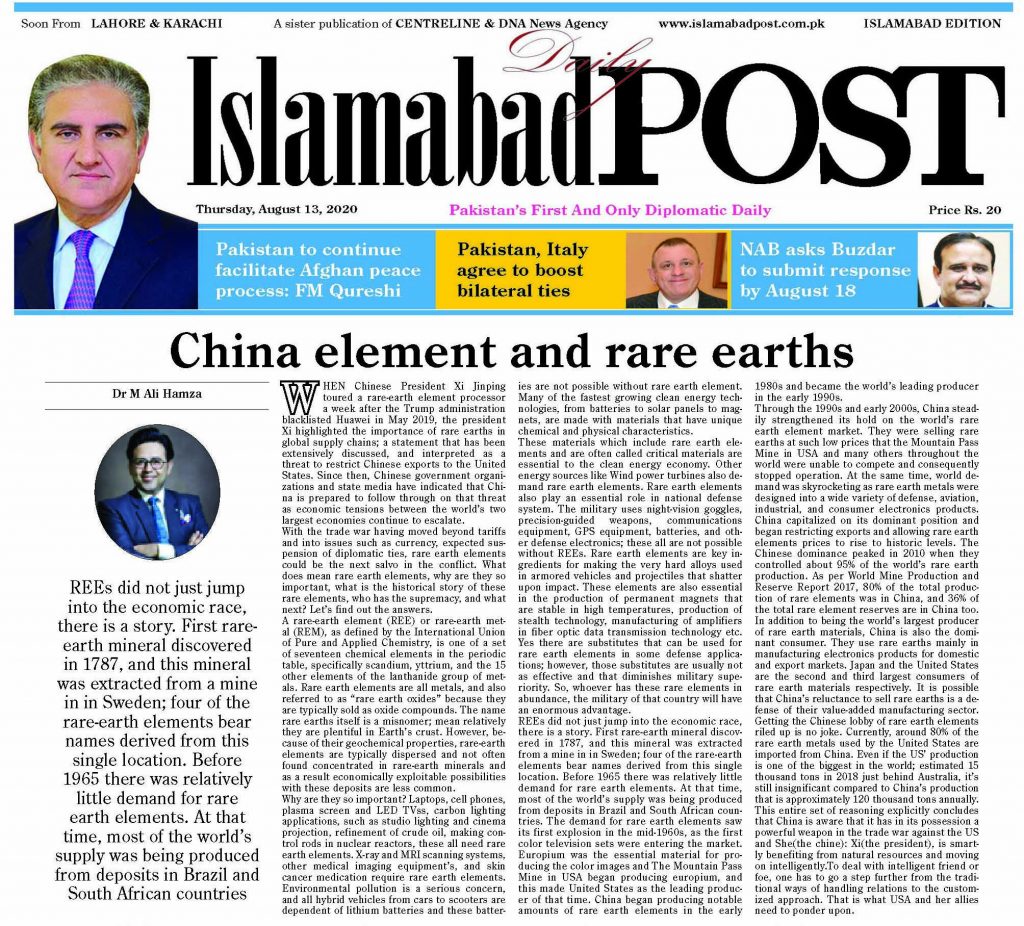Dr. Ali Hamza
When Chinese President Xi Jinping toured a rare-earth element processor a week after the Trump administration blacklisted Huawei in May 2019, the president Xi highlighted the importance of rare earths in global supply chains; a statement that has been extensively discussed, and interpreted as a threat to restrict Chinese exports to the United States. Since then, Chinese government organizations and state media have indicated that China is prepared to follow through on that threat as economic tensions between the world’s two largest economies continue to escalate. With the trade war having moved beyond tariffs and into issues such as currency, expected suspension of diplomatic ties, rare earth elements could be the next salvo in the conflict. What does mean rare earth elements, why are they so important, what is the historical story of these rare elements, who has the supremacy, and what next? Let’s find out the answers.
A rare-earth element (REE) or rare-earth metal (REM), as defined by the International Union of Pure and Applied Chemistry, is one of a set of seventeen chemical elements in the periodic table, specifically scandium, yttrium, and the 15 other elements of the lanthanide group of metals. Rare earth elements are all metals, and also referred to as “rare earth oxides” because they are typically sold as oxide compounds. The name rare earths itself is a misnomer; mean relatively they are plentiful in Earth’s crust. However, because of their geochemical properties, rare-earth elements are typically dispersed and not often found concentrated in rare-earth minerals and as a result economically exploitable possibilities with these deposits are less common.
Why are they so important? Laptops, cell phones, plasma screen and LED TVss, carbon lighting applications, such as studio lighting and cinema projection, refinement of crude oil, making control rods in nuclear reactors, these all need rare earth elements. X-ray and MRI scanning systems, other medical imaging equipment’s, and skin cancer medication require rare earth elements. Environmental pollution is a serious concern, and all hybrid vehicles from cars to scooters are dependent of lithium batteries and these batteries are not possible without rare earth element. Many of the fastest growing clean energy technologies, from batteries to solar panels to magnets, are made with materials that have unique chemical and physical characteristics. These materials which include rare earth elements and are often called critical materials are essential to the clean energy economy. Other energy sources like Wind power turbines also demand rare earth elements. Rare earth elements also play an essential role in national defense system. The military uses night-vision goggles, precision-guided weapons, communications equipment, GPS equipment, batteries, and other defense electronics; these all are not possible without REEs. Rare earth elements are key ingredients for making the very hard alloys used in armored vehicles and projectiles that shatter upon impact. These elements are also essential in the production of permanent magnets that are stable in high temperatures, production of stealth technology, manufacturing of amplifiers in fiber optic data transmission technology etc. Yes there are substitutes that can be used for rare earth elements in some defense applications; however, those substitutes are usually not as effective and that diminishes military superiority. So, whoever has these rare elements in abundance, the military of that country will have an enormous advantage.
REEs did not just jump into the economic race, there is a story. First rare-earth mineral discovered in 1787, and this mineral was extracted from a mine in in Sweden; four of the rare-earth elements bear names derived from this single location. Before 1965 there was relatively little demand for rare earth elements. At that time, most of the world’s supply was being produced from deposits in Brazil and South African countries. The demand for rare earth elements saw its first explosion in the mid-1960s, as the first color television sets were entering the market. Europium was the essential material for producing the color images and The Mountain Pass Mine in USA began producing europium, and this made United States as the leading producer of that time. China began producing notable amounts of rare earth elements in the early 1980s and became the world’s leading producer in the early 1990s. Through the 1990s and early 2000s, China steadily strengthened its hold on the world’s rare earth element market. They were selling rare earths at such low prices that the Mountain Pass Mine in USA and many others throughout the world were unable to compete and consequently stopped operation. At the same time, world demand was skyrocketing as rare earth metals were designed into a wide variety of defense, aviation, industrial, and consumer electronics products. China capitalized on its dominant position and began restricting exports and allowing rare earth elements prices to rise to historic levels. The Chinese dominance peaked in 2010 when they controlled about 95% of the world’s rare earth production. As per World Mine Production and Reserve Report 2017, 80% of the total production of rare elements was in China, and 36% of the total rare element reserves are in China too.

In addition to being the world’s largest producer of rare earth materials, China is also the dominant consumer. They use rare earths mainly in manufacturing electronics products for domestic and export markets. Japan and the United States are the second and third largest consumers of rare earth materials respectively. It is possible that China’s reluctance to sell rare earths is a defense of their value-added manufacturing sector. Getting the Chinese lobby of rare earth elements riled up is no joke. Currently, around 80% of the rare earth metals used by the United States are imported from China. Even if the US’ production is one of the biggest in the world; estimated 15 thousand tons in 2018 just behind Australia, it’s still insignificant compared to China’s production that is approximately 120 thousand tons annually.
This entire set of reasoning explicitly concludes that China is aware that it has in its possession a powerful weapon in the trade war against the US and She (the chine): Xi (the president), is smartly benefiting from natural resources and moving on intelligently. To deal with intelligent friend or foe, one has to go a step further from the traditional ways of handling relations to the customized approach. That is what USA and her allies need to ponder upon.

















